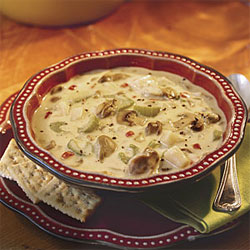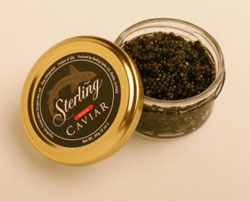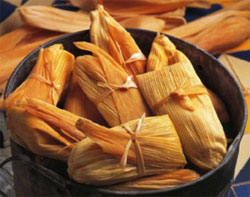I get more excited about food around the holidays than I do about presents–unless the presents involve good food. Most people have some kind of specialty food that they prepare during the holidays, often made from a recipe that’s been handed down through the family over the years –gastronomical cultural transmission, I like to call it. Or others just line up at Hickory Farms for a big chub of smoky summer sausage and one of those nifty cheese and meat baskets. No matter how you slice it, the holidays are about stuffing your gullet to the max, and then trying to shed the unwanted pounds in the new year. (That’s more of an American holiday tradition than anything!) Here’s a look at a few food traditions that are still thriving in the United States.
1) Holiday Aphrodisiac
 |
Oyster stew is a favorite tradition on Christmas Eve, especially in the Midwest, where, ironically, there are no saltwater bivalves. Usually it’s a simple stew–made with jarred oysters, flour, butter, and milk–served with bread or crackers. It seems odd that oyster stew would be so popular in places like North Dakota and Iowa, yet that’s what makes it so special–it’s often the only time of year when these farmer-types get to eat oysters. Watch out, Grandma Lena, Grandpa Ole is horny tonight.
2) Fruit Cake? Doorstop?
My step-dad is the only person that I know that likes fruitcake. His eyes light up like a child when he peels back the green foil on that aromatic loaf of candied fruit and nuts. Most people just fake enthusiasm when they are given fruitcake, and then use the damn thing as a doorstop. This holiday bread has its roots in Great Britain, where it’s known as plum cake. Some families take great pride in making elaborate fruitcakes during Christmastime, decorating them with colorful fruit, marzipan and rich icing.
3) More Stinky Fish, Please
Lutefisk is popular during the holidays in Norwegian communities, especially in the Pacific Northwest. It’s a laborious undertaking to make this stinky whitefish dish, and that’s why most Scandinavian markets sell the stuff at Christmastime–most people simply don’t have an interest in making lutefisk anymore. For those who insist on making it, patience is truly paramount because you first must soak the fish (most often cod) in cold water for the better part of 5 days and then cover it with lye for a few days–rendering it, for a time, inedible. To make the lutefisk edible, you then soak and rinse it again in cold water for 2 more days–before cooking the fish, which will have a jelly-like consistency. Lutefisk is generally served with lefse (a thin potato pancake), vegetables, gravy and stinky cheese.
4) What the Hell is Figgy Pudding?
There’s no doubt that figgy pudding, also known as plum pudding and Christmas pudding, is more popular in Great Britain than it is in America. But some folks in New England like themselves a little figgy pudding during the holiday season. This not-so popular pudding is really a cake–made in a bundt pan with dried figs, raisins, cherries, cranberries, flour, brown sugar, dark rum and lots of cinnamon, ginger and nutmeg. It’s actually quite good, regardless of its less-than-stellar reputation. Families gather around the holiday table, while mom flames the cake with a healthy dose of cognac or brandy. Careful: don’t light little Suzy’s new Christmas dress on fire.
5) Holiday Roe
 |
Caviar has a fabled history at the dinner table during Christmastime. This eastern European tradition is alive and well in the United States, where it’s often the only time of the year when people eat this creamy fish roe. Caspian Sea caviar, produced from beluga sturgeon, has long been the gold standard for caviar across the world. But because of negligent overfishing and poaching, many people are consciously avoiding caviar from the Caspian Sea. This moratorium has been a boon for American caviar producers, who put out nearly comparable products. Most domestic sturgeon caviar comes out of northern California and Idaho, while the Midwest (near the Missouri and Mississippi rivers) produces the most spoonbill caviar. Caviar is commonly served on Christmas Eve, with potato blini (little cakes), chopped onion and crème fraiche–washed down with some chilled vodka.
6) Hot Tamales
 |
Christmas tamales are a longstanding tradition in the Southwest, thanks to a strong Mexican influence in the region. I like tamales any time, yet I especially enjoy them during the holidays. This is the time of year when entire families get together to make dozens of tasty tamales, which get frozen and reheated throughout the holiday season. The most common tamales are made with rich masa harina dough and shredded chicken or pork–served with a zesty red tamale sauce. People of Central American descent also make tamales during the holidays, but the fillings are vastly different. Panamanians like to pack their tamales with pork, mustard pickles, prunes and green olives, and then drizzle them with a sauce made from the pork drippings.
7) That Salmon is Hard to Keep Lit
I like smoking salmon during the holidays. But I sometimes find it hard to keep them lit. All joking aside, smoked salmon is an excellent holiday gift, and it tastes wonderful on Christmas Eve with a little finely sliced red onion, capers and cream cheese–on baguette or good crackers. Most salmon that you buy, at least in the Pacific Northwest, has been smoked with alder or apple wood. This seems to be the norm for smoking techniques. Yet some folks like to purchase a whole king salmon and slowly cook it on a cedar plank, serving the lightly smoked fish with roasted red spuds, Brussels sprouts and a big bowl of mixed greens–splashed with apple cider vinaigrette.
8) Good Luck Peas
It’s widely believed that eating black-eyed peas on New Year’s Eve brings you good luck in the upcoming year. Regardless of all this hocus-pocus, I like to eat black-eyed peas on the last night of the year, served with a grilled ribeye steak, braised kale and cheesy grits. This tradition obviously hails from the Deep South, where many superstitious types huddle around a pot of stewed black-eyed peas every New Year’s Eve. Of course, there’s usually a big ham involved, as well as candied yams, collard greens and sweet corn bread. I’ve yet to receive any great rewards for eating this pea that’s really a bean. But black-eyed peas sure taste great. Maybe next year all that good luck is going to kick in.
